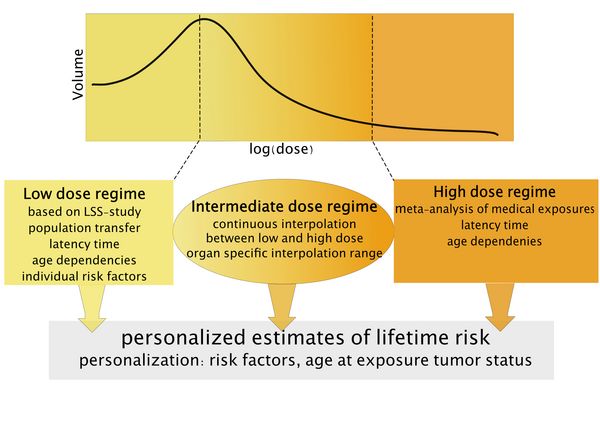A major challenge in the estimation of long-term risks in breast cancer radiotherapy are the complex dosimetric relationships. In radiotherapy, high doses with large dose gradients are induced in the organs close to the affected breast. In addition, the techniques are rapidly evolving, and modern techniques such as VMAT (Volumetric Modulated Arc Therapy) can produce significantly different dose distributions than traditional techniques such as 3D-CRT. It is therefore of great importance to develop models of radiation risk that cover the complete dose range from low to very high doses, in order to be able to assess the risks for modern techniques as well.
Therefore, in this work, models of radiation risk to the heart, lung, contralateral breast, and leukemia were developed by combining risk estimates from radiotherapy studies with estimates from radiation epidemiological studies of the low and intermediate dose range. Approximating cancer induction as a local process, organ cancer risks were estimated by integrating organ-specific dose-response relationships over the organ dose distributions. Fig. 1 gives an schematic overview of the development of the cancer risk models. For heart diseases, a linear dose-response model was used.
Fig. 1: Schematic overview of risk model developement
The risk estimates from the PASSOS software were compared with the risk estimates from a large clinical study of randomised trials, with good agreement for the exposure scenario applied in the clinics. Currently, the software is being further developed to give the user the possibility of using flexible dose distributions and to integrate the software into the clinical routine.
Contact: Dr. Markus Eidemüller
Publication:
Simonetto C, Wollschläger D, Kundrát P, Ulanowski A, Becker J, Castelletti N, Güthlin D, Shemiakina E, Eidemüller M. Estimating long-term health risks after breast cancer radiotherapy: merging evidence from low and high doses. Radiat Environ Biophys 2021;60, 459–474.doi.org/10.1007/s00411-021-00924-8
